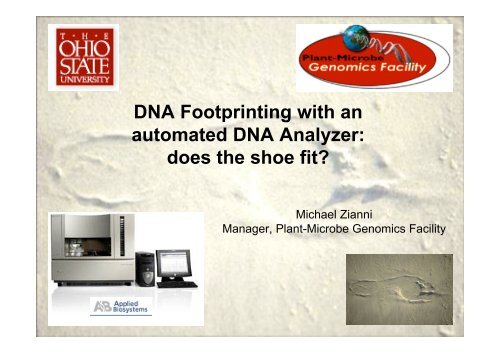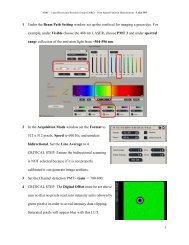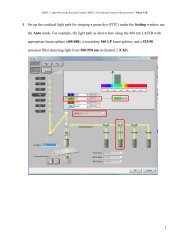DNA Footprinting with an automated DNA Analyzer: does the shoe fit?
DNA Footprinting with an automated DNA Analyzer: does the shoe fit?
DNA Footprinting with an automated DNA Analyzer: does the shoe fit?
You also want an ePaper? Increase the reach of your titles
YUMPU automatically turns print PDFs into web optimized ePapers that Google loves.
<strong>DNA</strong> <strong>Footprinting</strong> <strong>with</strong> <strong>an</strong><br />
<strong>automated</strong> <strong>DNA</strong> <strong>Analyzer</strong>:<br />
<strong>does</strong> <strong>the</strong> <strong>shoe</strong> <strong>fit</strong>?<br />
Michael Zi<strong>an</strong>ni<br />
M<strong>an</strong>ager, Pl<strong>an</strong>t-Microbe Genomics Facility
<strong>DNA</strong> <strong>Footprinting</strong> <strong>with</strong> <strong>an</strong><br />
Applied Biosystems 3730<br />
<strong>DNA</strong> <strong>Analyzer</strong>:<br />
<strong>does</strong> <strong>the</strong> <strong>shoe</strong> <strong>fit</strong><br />
……….yes!
6FAM<br />
rfu<br />
<strong>DNA</strong> Footprint Analysis<br />
<strong>DNA</strong> Binding Protein<br />
Size (bp)<br />
<strong>DNA</strong> Fragment<br />
Endonuclease<br />
Digestion<br />
(DNase I)<br />
6FAM 6FAM<br />
Capillary<br />
Electrophoresis<br />
6FAM<br />
6FAM 6FAM<br />
6FAM 6FAM<br />
6FAM<br />
rfu<br />
Size (bp)<br />
BSA
Development of <strong>DNA</strong> Foot print Analysis<br />
Techniques <strong>an</strong>d Goals of This Study<br />
First performed in 1977, <strong>an</strong>d utilized radioactively labeled<br />
<strong>DNA</strong>, slab gels, <strong>an</strong>d autoradiography<br />
In 1994, dyes <strong>an</strong>d fluorescent gel imager were used instead<br />
of radioisotopes <strong>an</strong>d autoradiography but <strong>the</strong> slab gel<br />
remained.<br />
In 2000, <strong>the</strong> slab gel <strong>an</strong>d imager were replaced by <strong>an</strong><br />
<strong>automated</strong> capillary electrophoresis instrument: 310 <strong>DNA</strong><br />
<strong>Analyzer</strong>.<br />
In 2004, ...........<br />
Demonstrate <strong>the</strong> feasibility by reproducing a protection assay<br />
previously done <strong>with</strong> autoradiography <strong>an</strong>d a slab gel<br />
Demonstrate that each peak could be accurately identified<br />
Apply this method to a previously uncharacterized protein
<strong>DNA</strong> Footprint <strong>an</strong>alysis <strong>with</strong> protein:<br />
Autoradiography vs Electropherogram
<strong>DNA</strong> Footprint <strong>an</strong>alysis <strong>with</strong>out protein:<br />
Electropherogram vs Autoradiography
Fluorescent Primer Design<br />
For use in: (1) <strong>the</strong> <strong>DNA</strong> sequencing reactions which act as a<br />
st<strong>an</strong>dard/ladder <strong>an</strong>d (2) <strong>the</strong> PCR reaction to make <strong>the</strong> <strong>DNA</strong> probe<br />
Used routine <strong>DNA</strong> sequencing guidelines:<br />
18 -25mer.<br />
Tm at 55 – 60C.<br />
about 50% GC.<br />
Primer purified by HPLC<br />
5’ label <strong>with</strong> FAM or VIC which worked well; HEX is okay
<strong>DNA</strong> sequencing reaction <strong>an</strong>d Analysis<br />
<strong>DNA</strong> probe made by PCR performed <strong>with</strong> labeled primers followed by a<br />
cle<strong>an</strong>ed up protocol, e.g. Qiagen PCR column<br />
Used ThermoSequenase Dye Primer <strong>DNA</strong> Sequencing Kit (USB Corp.)<br />
<strong>with</strong> <strong>the</strong> m<strong>an</strong>ufacturers protocol but at maximal values <strong>an</strong>d amounts.<br />
For each base/tube of a sequencing reaction used 0.2 to 2ul in 10ul<br />
HiDi <strong>an</strong>d 0.1ul LIZ 500 st<strong>an</strong>dards (Applied Biosystems)<br />
Analyze <strong>with</strong> 3730 <strong>DNA</strong> <strong>Analyzer</strong> (Applied Biosystems) using default<br />
Genemapper50-POP7-1 Run module, but in addition increased<br />
injection voltage to 3kV <strong>an</strong>d 30sec from 1.5kV <strong>an</strong>d 15sec respectively<br />
to increase signals<br />
All electropherograms were aligned <strong>with</strong> GeneMapper v3.5 or 3.7
A<br />
T<br />
G<br />
C<br />
<strong>DNA</strong> sequencing Reactions
Confirmation of Sequence by BigDye sequencing<br />
A<br />
T<br />
G<br />
C<br />
BigDye v3.1<br />
-58 C C G A T A T C A G C A T A T G A C G A T G G T T -34
Detailed <strong>DNA</strong> footprint protocol for CbbR<br />
CbbR<br />
LysR-type activator <strong>with</strong> a Helix-turn-helix motif that binds to <strong>the</strong> cbbI operon promoter<br />
of <strong>the</strong> photosyn<strong>the</strong>tic bacterium Rhodobacter sphaeroides<br />
Necessary for regulating carbon fixation genes in regards to redox state <strong>an</strong>d carbon<br />
dioxide concentration<br />
<strong>DNA</strong> fragment for digestion<br />
One primer labeled <strong>with</strong> 6-FAM <strong>an</strong>d o<strong>the</strong>r HEX; 285bp long<br />
PCR protocol: 25x of 30sec/95C – 30sec/50C – 60sec/72C<br />
PCR products were purified by Qiagen spin column <strong>an</strong>d qu<strong>an</strong>tified by UV<br />
spectrophotometry or by measuring FAM dye in spectrofluorometer.<br />
<strong>DNA</strong> footprint protocol<br />
Recombin<strong>an</strong>t CbbR was purified by several chromatography columns, <strong>an</strong>d refolding<br />
100 to 500ng of labeled probe was incubated <strong>with</strong> various amounts of CbbR protein<br />
(30mM potassium glutamate; 10mM Tris pH 8.5; 1mM DTT; 30% glycerol; 5mM<br />
MgAcetate; 2mM CaCl2; BSA 0.125mg/ml);<br />
Not a pure protein preparation so amount is unknown.<br />
Nuclease digestion was performed <strong>with</strong> various Kunitz units of DNase I (Worthington<br />
Biochemicals) per 500µl reaction for 5 – 30 min.<br />
The reaction was stopped <strong>with</strong> heat (5min at 95C)<br />
<strong>DNA</strong> fragments were purified in a Qiagen spin column.<br />
Footprint required const<strong>an</strong>t optimization of <strong>the</strong> amount of CbbR, DNaseI concentration,<br />
<strong>an</strong>d digestion time due to protein instability<br />
Dialysis performed to reduce salt inhibition during electrokinetic injection:<br />
Millipore membr<strong>an</strong>e (P/N VSWP02500) protocol<br />
For each digestion 1 – 5µl (from 50µl elut<strong>an</strong>t) in 10µl HiDi <strong>with</strong> 0.1µl LIZ-500 st<strong>an</strong>dards
<strong>DNA</strong> Footprint of CbbR <strong>an</strong>d cbbI promoter operon:<br />
sense str<strong>an</strong>d<br />
gc tc cc<br />
(-70,-69) (-39,-38) (-11,-10)<br />
Red – <strong>with</strong>out cbbR; black – <strong>with</strong> cbbR<br />
FAM labeled
<strong>DNA</strong> Footprint of CbbR <strong>an</strong>d cbbI promoter operon:<br />
<strong>an</strong>tisense str<strong>an</strong>d<br />
a c g ag gg gg<br />
(-12,-14,-16) (-42,-43) (-53,-54) (-71,-72)<br />
Red – <strong>with</strong>out cbbR; black – <strong>with</strong> cbbR<br />
Labeled <strong>with</strong> HEX
Detailed <strong>DNA</strong> footprint protocol for HrpY<br />
HrpY<br />
FixJ-type activator that has a Helix-turn-helix motif that binds to <strong>the</strong> hrpS<br />
promoter of <strong>the</strong> phytopathogen P<strong>an</strong>toea steweartii.<br />
Part of a two component system that is necessary for sensing a host, maize,<br />
<strong>an</strong>d activating <strong>the</strong> expression of <strong>the</strong> hrp proteins which are necessary for<br />
infection<br />
<strong>DNA</strong> fragment for digestion<br />
One primer labeled <strong>with</strong> 6-FAM; 386bp long<br />
PCR protocol: 25x of 30sec/95C – 30sec/50C – 60sec/72C<br />
PCR products were purified from gel <strong>an</strong>d qu<strong>an</strong>tified by UV spectrophotometry.<br />
<strong>DNA</strong> footprint protocol<br />
Recombin<strong>an</strong>t HrpY purified <strong>with</strong> a His tag column<br />
45 ng of labeled probe were incubated <strong>with</strong> amounts of HrpY protein r<strong>an</strong>ging<br />
from 0 to 140 uM in binding buffer (150 mM KCl, 5 mM MgCl2, 0.1 mM EDTA, 1<br />
mM DTT, 8% glycerol in 10 mM Tris-HCl pH 8.0).<br />
Nuclease digestion was performed <strong>with</strong> 0.0025 Kunitz units of DNase I<br />
(Worthington Biochemicals) per 20µl reaction for 5 min.<br />
The reaction was stopped <strong>with</strong> 0.25 M EDTA <strong>an</strong>d extracted <strong>with</strong> phenolchloroform-isoamyl<br />
alcohol (25:24:1).<br />
<strong>DNA</strong> fragments were purified in a Qiagen spin column.<br />
For each digestion 1 – 5µl (from 50µl elut<strong>an</strong>t) in 10µl HiDi <strong>with</strong> 0.1µl LIZ-500<br />
st<strong>an</strong>dards
K units of<br />
DNase I<br />
Optimization of DNase I digestion conditions for<br />
hrpS promoter<br />
0.05<br />
(over digested)<br />
0.005<br />
(over digested)<br />
0.0005 (good)<br />
0.00005<br />
(under digested)
HrpY <strong>DNA</strong> footprint <strong>an</strong>alysis <strong>with</strong> varying concentrations<br />
of tr<strong>an</strong>scription activator HrpY<br />
140µM HrpY<br />
0µg BSA<br />
70µM HrpY<br />
6µg BSA<br />
35µM HrpY<br />
9µg BSA<br />
17.5µM HrpY<br />
10µg BSA<br />
4.3µM HrpY<br />
12µg BSA<br />
2µM HrpY<br />
12µg BSA<br />
0µM HrpY<br />
12µg BSA<br />
Region of Interest<br />
I II
HrpY<br />
BSA<br />
A<br />
T<br />
G<br />
C<br />
<strong>DNA</strong> footprint Analysis: alignment <strong>with</strong> <strong>DNA</strong> sequence<br />
-126 TATGTAACCGTTTTCATTTCACACAGGGTTAGTCAGGAAATCCTTACAATCCTCCATC -69<br />
I<br />
HrpY<br />
BSA<br />
A<br />
T<br />
G<br />
C<br />
II<br />
-68 AATTCCTTACCCGATATCAGCATATGACGATGGTTTATCTGTGCTGAAT -19<br />
♣Green box – protected regions<br />
♣Red box – hypersensitive regions<br />
♣I <strong>an</strong>d II are distinct regions that <strong>fit</strong> binding motif:<br />
♣1) T- N 11 –A<br />
♣2) centered about -70 from tr<strong>an</strong>scription start<br />
site
Region I overlayed <strong>with</strong> GeneMapper 3.7.<br />
-126 T A T G T A A C C G T T T T C A T T T C A C A C A G G G T T A G T C A G G A A A T C C T T A C A A T C C T C C A T C -69<br />
Upper p<strong>an</strong>el : red – <strong>with</strong>out HrpY; blue - <strong>with</strong> HrpY<br />
Lower p<strong>an</strong>el: red – t; green –a; blue – c; black - g
Region II overlayed <strong>with</strong> GeneMapper 3.7.<br />
-68 A A T T C C T T A C C C G A T A T C A G C A T A T G A C G A T G G T T T A T C T G T G C T G A C A T -19<br />
Upper p<strong>an</strong>el : red – <strong>with</strong>out HrpY; blue - <strong>with</strong> HrpY<br />
Lower p<strong>an</strong>el: red – t; green –a; blue – c; black - g
<strong>DNA</strong> primer extension <strong>an</strong>alysis to determine <strong>the</strong><br />
tr<strong>an</strong>scription start site for hrpS gene of P<strong>an</strong>toea stewartii<br />
tatgtttacGaagtgcttacagggg agataaaCcatcg<br />
Two tr<strong>an</strong>scription start sites were identified (purple peaks;<br />
capitalized text). Red – t; green – a; black – g; blue – c.
Primer Extension Protocol to Map<br />
Tr<strong>an</strong>scription start site of hrpS gene<br />
1) RNA prepared from Eth<strong>an</strong>ol/phenol stopped cultures using Promega Total<br />
RNA kit<br />
2) Add 30-50 ug Total bacterial RNA per reaction<br />
3) Mix 50 ug RNA <strong>with</strong> 100 pmol 6FAM primer in 30 ul total<br />
4) Heat at 90C for 3 min, <strong>the</strong>n slow cool to 30C in PCR machine<br />
5) Syn<strong>the</strong>size c<strong>DNA</strong> as follows:<br />
a) mix 6 ul 0.1M DTT, 12 ul 1st str<strong>an</strong>d buffer (GIBCO) 1.5 uL 25 mM<br />
dNTP, 4 uL Superscript II, 2 ul RNasin, 0.5 ul water<br />
b) incubate at 42C for 1 h<br />
c) add 2 ul superscript II<br />
d) incubate at 42C for 1 h<br />
6) Degrade RNA adding 10 ul 1 M NaOH <strong>an</strong>d by heating at 70C x10min<br />
7) Neutralize <strong>with</strong> 10 ul 1 M HCl<br />
8) Purify <strong>with</strong> Qiagen PCR prep kit (Minelute version) in 15 ul water.<br />
9) Combine 1 to 5ul <strong>with</strong> 10ul HiDi/0.1ul LIZ 500 st<strong>an</strong>dards<br />
10) Analyze <strong>with</strong> 3730 <strong>DNA</strong> <strong>Analyzer</strong>
Those who helped <strong>an</strong>d more:<br />
Kim Tess<strong>an</strong>ne, Pl<strong>an</strong>t-Microbe Genomics<br />
Facility<br />
F. R. Tabita, Pl<strong>an</strong>t-Microbe Genomics Facility<br />
Director; OSU Dept of Microbiology<br />
Rick Laguna, OSU Dept of Microbiology<br />
Max Merighi, OSU Dept of Pl<strong>an</strong>t Pathology





